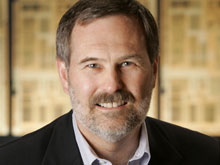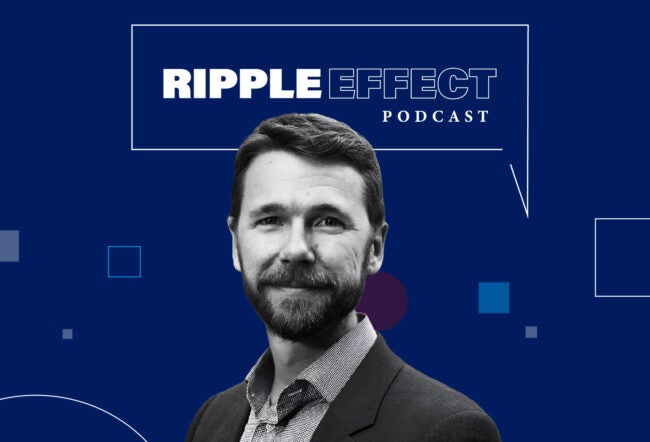What does the rapidly unfolding pension crisis in the United States have to do with venture capital firms in Silicon Valley? A lot, according to Keith Larson, a vice president at Intel Capital and a managing director of the manufacturing sector, Taiwan, Korea and Latin America. In a presentation at Wharton San Francisco, Larson outlined how massive pools of money largely dedicated to safeguarding the retirements of municipal, state and federal workers across the country pumped the venture capital ecosystem full of cash for the decade prior to the current recession — and then dramatically reversed course.
In addition, Larson said, reverberations from the ongoing contraction in the venture capital industry are only the first signs of an inevitable and significant tightening in the sector. “I have heard some estimates of a contraction on the order or 25% or greater in the number of funds and the number of people working in venture capital.” What lies ahead, he suggested, are some tough political decisions on right-sizing pension benefits — decisions that would seem to bode poorly for future sources of income for venture capital and private equity funds used to receiving money from public pension retirement funds.
Larson not only serves as one of the country’s most prominent venture capitalists at Intel’s $1.9 billion dollar captive corporate fund, but also is a member of the board of directors of the Oregon Investment Council (OIC), an advisory group that manages roughly $60 billion in pension funds for state workers in Oregon. Larson said that, at its core, the big problem pension funds face is an issue that has already been settled by many companies in the private sector — the transition from defined benefit retirement funds to defined contribution retirement funds. In defined benefit plans, employees receive a guaranteed retirement payout. In defined contribution plans, such as 401(k)s, retirement investing is left up to the employee, and there are no guaranteed payouts.
Even before the financial crisis, public pension funds in the U.S. had been extremely underfunded. Abnormally and unsustainably high investment returns for pension funds lulled many public fund managers and government officials into believing that the underfunding problem would be resolved without any painful cuts to benefits, Larson noted. That illusion was shattered by real estate crashes in several nations and accompanying dips in virtually all asset classes around the globe over the past three years. “This had two profound effects on the public pension funds,” Larson pointed out. “First, their investments in alternative assets became illiquid. Second, the funds became underfunded even more than before.”
Painful Choices
While private sector entities had already moved decisively to cut pension burdens, such movements in the public sector will likely take far more time to evolve. “How does this play out over time? Cash inflows have become less than cash outflows for most funds,” Larson said. This necessarily results in a choice between potentially painful outcomes. One is raising taxes — an idea the public is increasingly hostile toward. Another is cutting employees or curtailing benefits, which the politically powerful public workers unions are strongly against.
Recognizing the need to increase the return on their assets, many public pension funds funneled big chunks of money into alternative asset classes over the past 10 years, which can potentially provide higher returns but can also carry more risk. Part of what attracted pension funds to the venture capitalists, Larson pointed out, was that the venture industry was growing. What had previously been a smaller, cottage industry turned into a sector where multi-billion dollar funds became commonplace during the dotcom bubble. This abated after the bubble burst, then resumed with the stronger economy and clean tech investment surge fueled by the spikes in oil prices during 2006 and 2007.
As public pension funds chased higher and higher returns in private equity and venture capital, the massive influx of money inevitably drove returns down as more money chased the same deal flow, and prices for stakes in viable early-stage companies inflated to historic levels. “The returns had to come down. There was a lot of money pouring into the space,” Larson noted. Against this backdrop of inflated company valuations, illiquidity struck on a broad market scale. Many pension funds almost overnight found they could no longer count on issues such as auction rate securities or even money market funds. When one prominent money market fund “broke the buck” by returning less than $1 per share to investors, pandemonium broke out, he said.
Public pension funds quickly reacted by stopping nearly all venture capital investing activity, according to Larson. What’s more, the pension funds began to refuse capital calls from venture funds that were counting on cash infusions from limited partners who had signed up to contribute money on an as-needed basis for general partners to tap for deals. Many battered venture capital funds themselves became even more illiquid and posted big valuation drops as limited partners shopped their shares on secondary markets, often for pennies on the dollar.
Other limited partners began to demand capital back from their venture fund investments or demand that the VC funds raise cash by selling off portfolio companies. “Simply put, this dynamic has driven many funds out of business,” noted Larson, who does not think that the consolidation of venture funds is over. While all of this sounds exceedingly bleak for a young venture capitalist starting out, Larson noted that top-tier funds continue to log strongly positive returns and that “the very best-managed big-name funds have maintained strong performance and will continue to do so even as this contraction plays out.”
The ‘Best Time to Invest’
Larson described Intel Capital as a rare entity, a large enough fund to weather the ongoing venture capital storm and one that is also completely corporate-funded and therefore not dependent on pension funds or other large public investors. What’s more, Larson suggested that even as the global economy is slowing, opportunities for great venture investments have never been better. “Innovation is continuing. In fact, we are in a remarkable period of innovation despite the down economy,” said Larson, citing advances in technology — from social networking to new types of semiconductors to alternative energy breakthroughs. Intel Capital has not slowed the pace of its venture investments. “We as a company see down periods as the best time to invest. That’s always been the Intel culture.”
That said, Larson agrees with some experts that the looming pension crisis is big, and that pending decisions to resolve the giant pension overhang faced by states still reeling from losses of tax revenue — many caused by the economic downturn — will be a true test of political will. He predicted that public pension fund managers and state politicians will face the choice of either switching to a defined contribution model or a greatly reduced defined benefit model. “They need a gold swan to lift their returns. Barring that, I think politicians who are on their way out of office will have the easiest time making the tough choices that need to be made. Not facing reelection allows for intellectual honesty.”
Likewise, Larson said numerous failing venture funds would need a near miracle on a global scale to lift the value of their portfolios into the black. That could come in the form of a hockey-stick economic recovery in the U.S. or a resumption of the past stock market gains and ensuing IPO parades that emboldened limited partners to plunge into venture capital and private equity funds. With the U.S. unemployment rate actually rising and growth in many parts of the world decelerating, such a recovery appears unlikely any time soon. But, noted Larson, “successful investors bringing more than just dollars to the table — bringing expertise, networks and value beyond their wallets — will continue to do well. There’s no doubt about that.”



